Chess
Notes
|
| First column | << previous | Archives [68] | next >> | Current column |
6495. Banks on Marshall
Page 7 of Banks’ Blindfold Checker Masterpieces by Newell W. Banks (Philadelphia, 1947) quoted his view of F.J. Marshall:
‘I received more good ideas on opening and mid-game chess play from my old friend Frank Marshall than from all the other chessplayers I have known. If Marshall had had the urge to continue to apply himself to study and analysis he could have been at the top all his life. He was the greatest natural player of them all.’
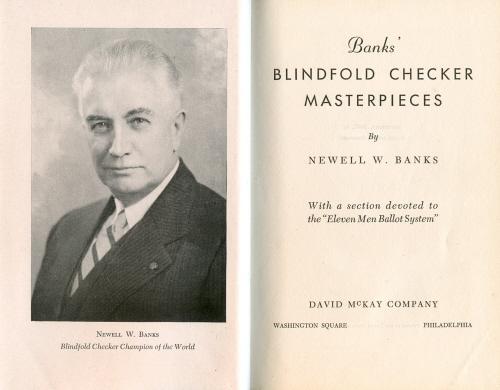
6496. Quiz question (C.N. 6424)
A last call for proposals concerning the question posed in C.N. 6424: what was the largest number of opponents ever faced by Morphy in a simultaneous exhibition?
6497. Signatures
For readers who enjoy identifying signatures, we give another illustration from our collection (the 1982 Dover edition of Chernev’s book on Capablanca):
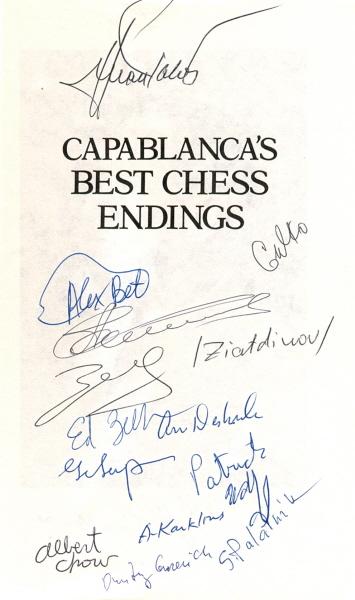
6498. G. Levenfish
Javier Asturiano Molina (Murcia, Spain) asks about the correct spelling of Levenfish/Löwenfisch.
Both are commonly seen, with a distinct trend nowadays
towards the former in many countries. The German
rendition ‘Löwenfisch’ or ‘Loewenfisch’ was particularly
common in English-language literature in the first half
of the twentieth century, although the BCM
sometimes had ‘Lövenfisch’. The 1971 volume Dizionario
enciclopedico degli scacchi used ‘Levenfisch’. The
last two spellings mentioned may be regarded as
non-standard.
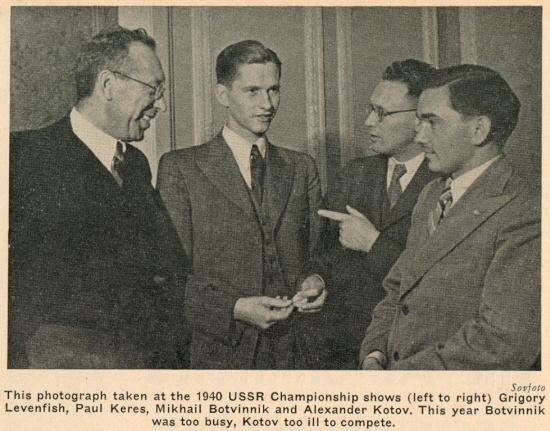
The above photograph was published in Chess Review, April 1947, page 9.
6499. Claim about Janowsky
From an article ‘Tall Tales of Teetotalers’ by H. Kmoch and F. Reinfeld on pages 136-137 of the May 1952 Chess Review:
‘He considered himself the strongest player of all time ...’
What are the grounds for asserting that such was Janowsky’s belief?
6500. Che Guevara (C.N.s 4803, 4809 & 4934)
David Jarrett (Athens) sends three photographs which he acquired some years ago. Readers’ assistance with identifying other figures (in addition to Gligorić and Smyslov) will be appreciated.
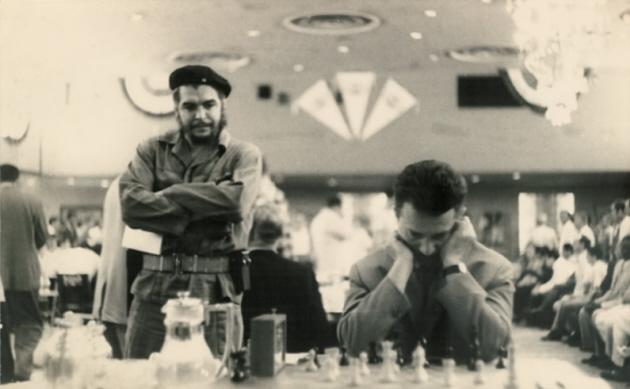
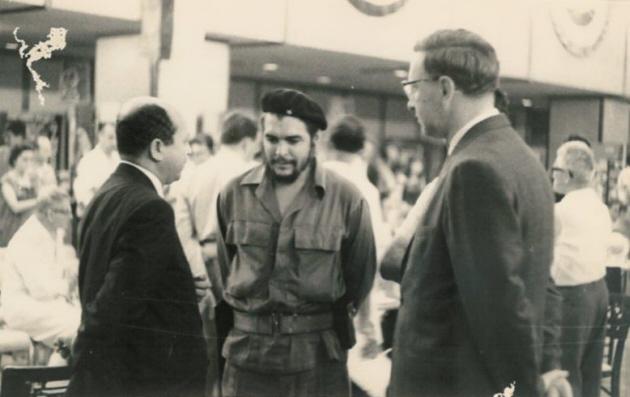
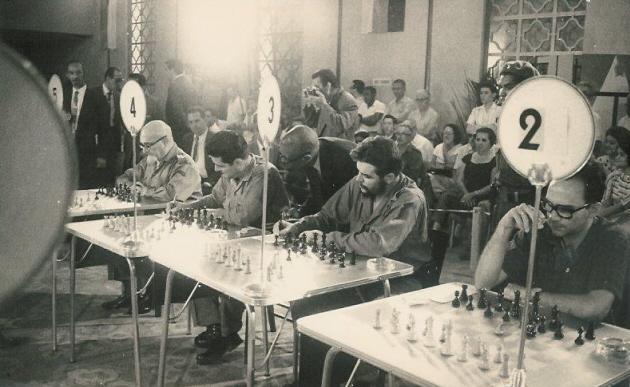
6501. James H. Taft (C.N.s 64 & 5170)
John Blackstone (Las Vegas, NV, USA) draws attention to page 3 of the Brooklyn Daily Eagle of 20 July 1916, which had some information about J.H. Taft, including his birth-date: 3 March 1888.
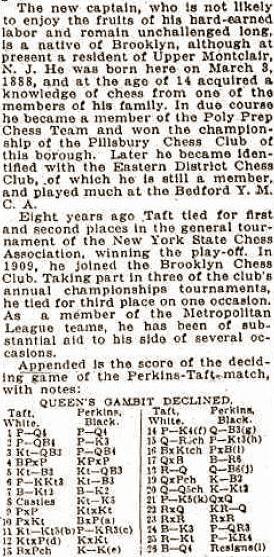
In the game given, 11 Ng5 was described as ‘an important and promising departure from the books’.
James H. Taft – Frank Kendall PerkinsNew York, 1916
Queen’s Gambit Declined
1 d4 d5 2 c4 e6 3 Nc3 c5 4 cxd5 exd5 5 Nf3 Nc6 6 g3 Nf6 7 Bg2 Be7 8 O-O Ne4 9 dxc5 Nxc3 10 bxc3 Bxc5
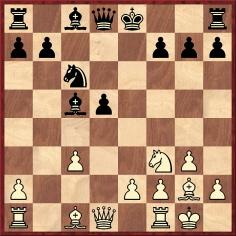
11 Ng5 h6 12 Nxf7 Kxf7 13 Bxd5+ Ke8 14 e4 Qf6 15 Qh5+ g6 16 Bxc6+ bxc6 17 Qxc5 Bh3 18 Rd1
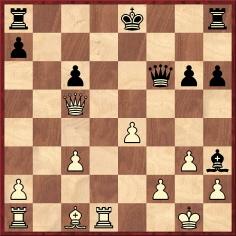
18...Qf3 19 Qxc6+ Kf7 20 Qd5+ Kg7 21 e5 Qxd5 22 Rxd5 Rhd8 23 Rxd8 Rxd8 24 Be3 a6 25 Re1 h5 26 Bd4 Resigns.
The game was played in a short match at the Brooklyn Chess Club (won by Taft +1 –0 =3) which was also mentioned on page 223 of the November 1916 American Chess Bulletin.
Our correspondent provides too a match-game from page 3 of the Brooklyn Daily Eagle, 27 July 1916:
James H. Taft – Alvin Cushing CassNew York, 25 July 1916
Queen’s Gambit Declined
1 d4 d5 2 c4 c6 3 e3 Nf6 4 Nc3 g6 5 Bd3 Bg7 6 Nf3 Nbd7 7 O-O O-O 8 e4 dxc4 9 Bxc4 Nb6 10 Be2 Be6 11 Ng5 Qd7 12 Be3 Rfd8 13 Nxe6 Qxe6 14 Qc2 Rd7 15 Rad1 Rad8 16 h3 h5 17 e5 Nfd5 18 Ne4 Nxe3 19 fxe3 Bh6 20 Nc5 Bxe3+ 21 Kh1 Qxa2 22 Nxd7 Rxd7
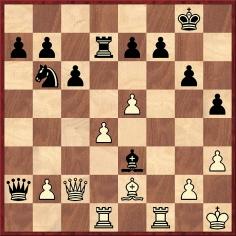
23 d5 Nxd5 24 e6 Rd6 25 exf7+ Kf8 26 Ra1 Nb4 27 Qc3 Bd4 28 Qxb4 Qe6 29 Qxb7 Rd8 30 Rae1 Qd6 31 Bf3 Bb6 32 Qxc6 Qb4 33 Rd1 Rb8 34 Qe8+ Resigns.
6502. ‘The poetry of chess’ (C.N.s 5223, 5290 & 5347)
In the second half of the nineteenth century, problems were sometimes referred to as ‘the poetry of chess’, but who coined the description?
The earliest citation that we can offer is on page 271 of Daniel W. Fiske’s book on New York, 1857:
‘Problem-making has been very properly denominated the poetry of chess. The same depth of imagination, the same fecundity of invention, the same quick perception of the beautiful, which characterize the poet, belong also to the chess strategist.’
6503. Masters’ reports on simultaneous displays (C.N.s 6198 & 6333)
Michael Clapham (Ipswich, England) quotes from a posthumous article ‘Simultaneous Displays from the Inside’ by B.H. Wood on pages 36-37 of the December 1991 CHESS:
‘Curiously, I cannot recall, in the whole of chess literature, any article by the soloist himself in simultaneous displays.’
6504. Soultanbéieff (C.N. 6486)
Stéphane Pilawski (Liège, Belgium) reports that he has a copy of Soultanbéieff’s Guide pratique du Jeu des Combinaisons inscribed to Louis Malpas:
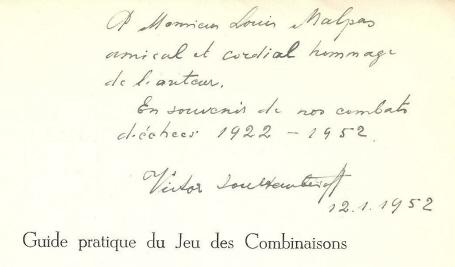
From pages 47-49 of the book we give the score of ‘une partie extraordinairement intéressante et mouvementée’ (Znosko-Borovsky):
Victor Soultanbéieff – M. KreimerLiège (summer tournament), 1928
French Defence
1 d4 e6 2 e4 d5 3 Nc3 dxe4 4 Nxe4 Nf6 5 Bg5 Be7 6 Bxf6 gxf6 7 Nf3 Rg8 8 Qd2 Nc6 9 Qh6 Rg6 10 Qxh7 Qd5 11 Qh8+ Kd7 12 Nc5+ Bxc5 13 dxc5 Qe4+ 14 Be2 Ke7
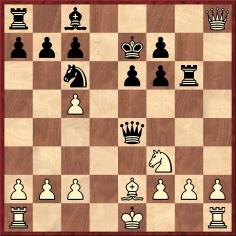
15 O-O-O Qxe2 16 Nd4 Nxd4 17 Rxd4 e5 18 Rd8
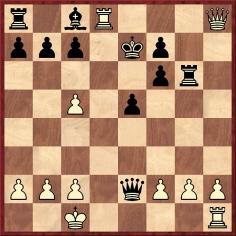
18...Qxc2+ 19 Kxc2 Bf5+ 20 Kc1 Rxd8 21 Qh5 Rg5 22 Qf3 Rd3 23 Qxb7 Rg4 24 Qa6 Rgd4
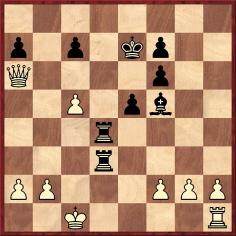
25 g4 Bg6 26 f4 Rxf4 27 Rd1 Rxd1+ 28 Kxd1 Rd4+ 29 Ke2 Rxg4 30 Qxa7 Kd7 31 Qb7 Be4 32 Qb3 Ke7 33 h3 Rg2+ 34 Kf1 f5 35 Qb4 Bc6 36 Qh4+ f6 37 Qh7+ Ke6 38 Qxc7 Bf3 39 Qc8+ Kf7 40 Qxf5 Bc6 41 Qc8 Be4 42 c6 Rxb2 43 Qd7+ Kg6 44 Qg4+ Resigns.
Soultanbéieff also annotated the game on pages 1012-1013 of L’Echiquier, September 1928.
6505. Adolf Schwarz on Steinitz (C.N.
4375)
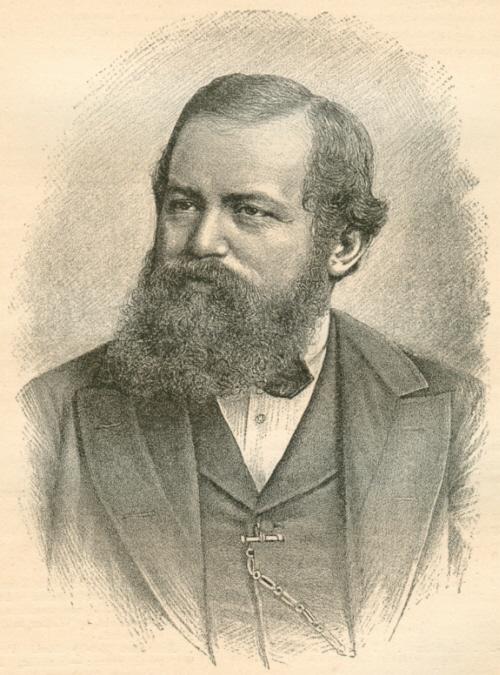
W. Steinitz. Source: Chess Monthly, March 1891, page 193
‘This little man has taught us all how to play chess’ is a famous remark about Steinitz by Adolf Schwarz, as discussed in C.N. 4375. Here we add a nineteenth-century citation, from page 165 of the August 1897 American Chess Magazine:
‘The chess world owes a debt of gratitude to the past-master, and here is an opportunity to partly repay it. At the Vienna tournament of 1882 the noted chess master Adolph Schwartz [sic], pointing to Steinitz, said, “This little man has taught us all to play chess”, and no truer word was ever spoken. He is the father of modern play, and Lasker, Pillsbury, Tarrasch, in fact all who rank high in chess, willingly acknowledge in him their teacher. Paraphrasing a well-known saying, one can stick a pin at random in any handbook and one will find an innovation by Steinitz and adopted since by the chess world. Moreover, he was the pioneer of scientific annotation, and the best analysts of the day are his pupils.’
An alternative version of the remark under discussion:
‘... Dr Emanuel Lasker said, “This little man taught us all we know”.’
Source: page 17 of Ray Keene’s Good Move Guide by R. Keene and A. Whiteley (Oxford, 1982).
6506. Wilson and Labourdonnais
From Rod Edwards (Victoria, BC, Canada):
‘On page 112 of his book Chess & Chess-Players (London, 1850) George Walker wrote:
“My friend, Harry Wilson, once gave De la Bourdonnais the knight.”
Page 879 of A History of Chess by H.J.R. Murray (Oxford, 1913) states:
“In 1815, Harry Wilson, who was playing even with Lewis in 1819, had played with De la Bourdonnais, giving him the odds of the knight.”
In that footnote Murray cites Deutsches Wochenschach, 1912, pages 1-7, for a life of Labourdonnais but does not make it clear whether his information about the Frenchman’s play against Wilson is derived from that source. Where does the information come from (Walker’s book does not mention the year), and is anything more known about games between the two players?’
The article, by O. Koch, in Deutsches Wochenschach does not refer to Wilson, but the year 1815 was given by George Walker a few years before the appearance of his book Chess & Chess-Players. In an article dated October 1843 about the McDonnell v Labourdonnais games Walker wrote on page 371 of that year’s Chess Player’s Chronicle:
‘In 1815, my friend Harry Wilson gave De la Bourdonnais, in Paris, the Knight in odds.’
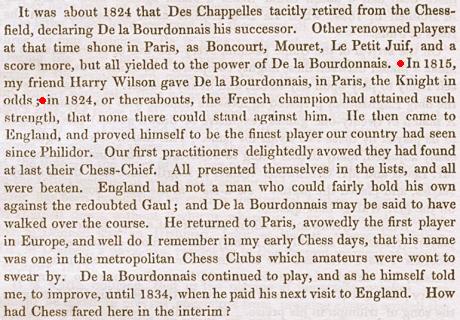
Walker’s account was not disputed by Wilson, whose familiarity with the Chronicle is shown by his writing about other matters on pages 57-58 and 146-150 of the 1844 volume.
An obituary of Wilson was published on page 57 of the Chronicle in 1851:
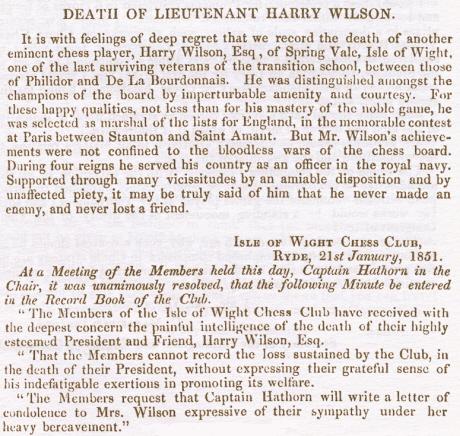
We also note the follow item about ‘Philidor’s Chess Board’ on page 108 of the Chess World, 1867:
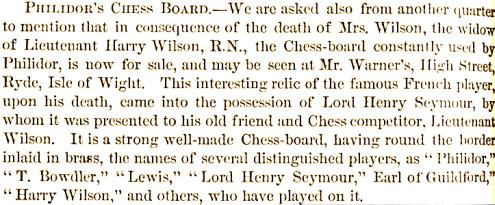
The present item ends with a specimen of Harry Wilson’s play:
Piercy – Harry WilsonOccasion? (circa 1844)
Sicilian Defence
1 e4 c5 2 c3 Nc6 3 Nf3 e6 4 d4 d5 5 e5 Nge7 6 Bb5 Qb6 7 a4 Bd7 8 Bxc6 Nxc6 9 O-O c4 10 Qe2 Be7 11 Bf4 Na5 12 Na3 Nb3 13 Ra2 Qa6 14 Nd2 Nxd2 15 Qxd2 Bxa4 16 Nc2 Qc6 17 Rfa1 b5 18 Nb4 Bxb4 19 cxb4 O-O 20 Ra3 a5 21 Rg3 Ra7 22 Rc1 f5 23 b3
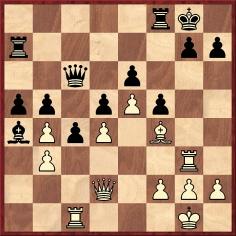
23...axb4 24 bxa4 c3 25 Qe2 bxa4 26 Qh5 a3 27 Bh6 Rff7 28 Qg5 Qc8 29 Qe3 a2 30 Qe1 f4 31 Rg4 b3 32 Bxf4
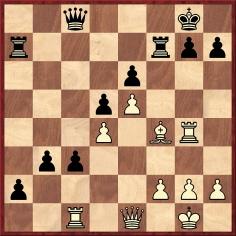
32...b2 33 Rxc3 Qxc3 34 Qxc3 a1(Q)+ 35 White resigns.
Source: Chess Player’s Chronicle, 1844, pages
202-203, where White is referred to as ‘Mr Piercy, of
the Military College, Sandhurst’. No forename was
supplied, but page 44 of the February 1884 BCM
mentioned John Piercy, a deceased professor at
Sandhurst.
6507. Alekhine at Prague, 1931
Jan Kalendovský (Brno, Czech Republic) sends two photographs of Alekhine at the 1931 Olympiad in Prague:
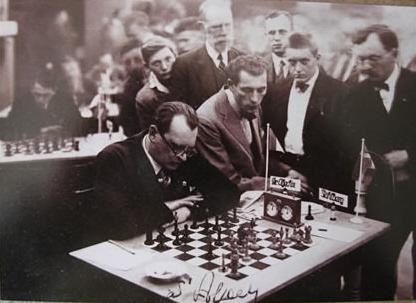
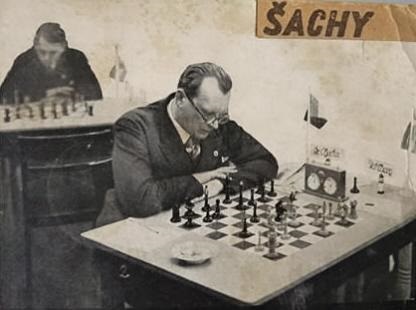
We note that a cropped version of the first photograph was published on page 153 of the September-October 1931 American Chess Bulletin:
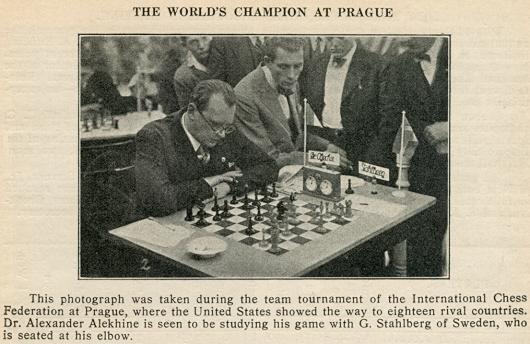
6508. Blackburne v Gunsberg
Three years before playing Steinitz for the world championship, Gunsberg lost a match-game in 11 moves:
Joseph Henry Blackburne – Isidor Arthur GunsbergEighth match-game, Bradford, 6 October 1887
Ruy López
1 e4 e5 2 Nf3 Nc6 3 Bb5 Nf6 4 Qe2 a6 5 Ba4 Bc5 6 c3 b5 7 Bc2 d5 8 exd5 Qxd5 9 d4 Bd6 10 Bb3 Qe4 11 Qxe4 Resigns.
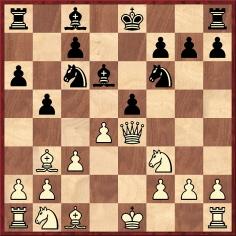
Sources: BCM, November 1887, pages 429-430 (which included the players’ brief notes) and Chess Monthly, December 1887, pages 112-113.
There are databases which have the move order as 3...a6 4 Ba4 Nf6 5 Qe2 Bc5 and, even, are wrong about the occasion of the game (e.g. giving the date as 1890).
6509. The Důras Attack
The famous game Blackburne v Lipschütz, New York, 1889 began 1 d4 d5 2 c4 e6 3 Nc3 Nf6 4 Nf3 b6 5 Bg5 Be7 6 e3 Bb7 7 Rc1 Nbd7 8 cxd5 exd5:
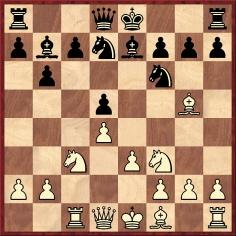
Now Blackburne played 9 Bd3, and on page 55 of Lessons in Chess Strategy (London, 1968) W.H. Cozens commented:
‘The Důras Attack (Game 12) was of course unknown at the time.’
Game 12 was Marshall v Klein, New York, 1913, where a similar position was discussed, on page 39:
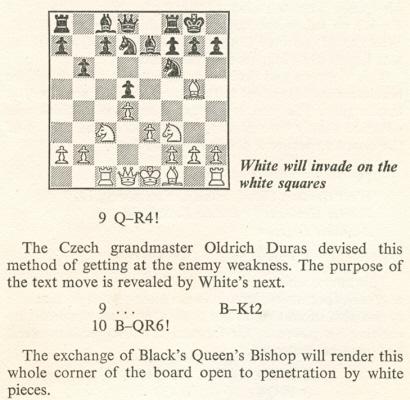
Page 143 of Marshall’s autobiographical games collection described 9 Qa4 in that game as ‘an interesting move suggested by Důras’.
The term Důras Attack gained currency during the 1921 world championship. Amos Burn’s review of the match (see pages 106-107 of the May-June 1921 American Chess Bulletin) included this remark:
‘In the first and fifth games, for example, in the Queen’s Pawn opening, Lasker, in reply to 7 R-B, played 7...P-QKt3 instead of 7...P-B3, apparently unaware of the force of the Důras attack of Q-R4. In the first game Capablanca did not take advantage of this mistake, but in the fifth he played the Důras move and won a pawn.’
Pages 210-212 of the May 1922 BCM gave a game between R.H.V. Scott and E.G. Sergeant (see page 105 of A Chess Omnibus) which began 1 d4 d5 2 c4 e6 3 Nc3 Nf6 4 Bg5 Be7 5 Nf3 Nbd7 6 e3 O-O 7 Rc1 b6. The annotator, Sir George Thomas, now wrote:
‘This move allows White the option of the Důras attack, to which a good deal of attention has been directed recently. No very definite conclusion has yet been reached as to the effect of that attack; and though the general view seems to be that Black, in submitting to it, burdens himself with unnecessary difficulties, a strong minority (which evidently includes both players in this game) dissent from that opinion.’
Two games in which Důras played the Qa4 attack, at Breslau, 1912, may be mentioned:
1 d4 d5 2 Nf3 Nf6 3 c4 e6 4 Nc3 Be7 5 Bg5 O-O 6 e3 Nbd7 7 Rc1 b6 8 cxd5 exd5 9 Qa4 Bb7 10 Ba6 Bxa6 11 Qxa6 (Důras v Balla);
1 d4 d5 2 Nf3 Nf6 3 c4 e6 4 Nc3 Nbd7 5 Bg5 Be7 6 e3 O-O 7 Rc1 b6 8 cxd5 exd5 9 Qa4 Bb7 10 Ba6 Bxa6 11 Qxa6 (Důras v Marshall).
The same kind of manoeuvre had, however, already been seen:
1 d4 d5 2 Nf3 e6 3 c4 c5 4 e3 Nc6 5 Nc3 Nf6 6 Be2 Bd6 7 O-O O-O 8 a3 b6 9 dxc5 bxc5 10 Qa4 Bb7 11 cxd5 exd5 12 Rd1 Qe7 13 Ba6 Ne5 14 Bxb7 Nxf3+ 15 gxf3 Qxb7 (Showalter v Lawrence, Cambridge Springs, 1904);
1 d4 d5 2 c4 e6 3 Nc3 Nf6 4 Bg5 Nbd7 5 e3 Be7 6 Nf3 b6 7 Bd3 Bb7 8 cxd5 exd5 9 O-O Ne4 10 Bf4 Rc8 11 Qa4 O-O 12 Ba6 Ndc5 13 dxc5 Nxc5 14 Qd4 Bxa6 (Asztalos v Székely, Budapest, 1911).
6510. Golombek and Reuters
Harry Golombek’s Modern Opening Chess Strategy (London, 1959) was dedicated to Sidney Weiland of Reuters (‘but for whom the following pages might never have been written’), and the Acknowledgements page thanked Reuters ‘for their kind permission to reproduce much of the material in this book’.
Information on Golombek’s connection with Reuters at that time would be welcome, and particularly since the book comprised detailed openings analysis and not news or reportage.
Below is an inscription by Golombek (Dundee, 1967) in one of our copies of Modern Opening Chess Strategy:
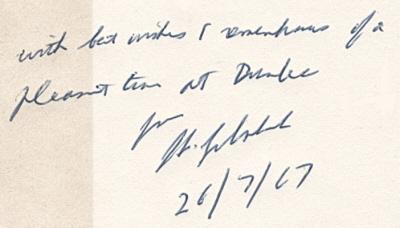
As regards his (later) work as a correspondent for the news agency, the following appeared in the announcement of his book on the 1972 world championship match in the February 1973 CHESS:
‘Golombek was at Reykjavik reporting for The Times and Reuter throughout the play.’
6511. Noble game
From the first paragraph of Arthur Koestler’s introduction (page 7) to Fischer v Spassky by H. Golombek (London, 1973):
‘In the prehistoric days before the great match started and this book was written, I wrote in the Sunday Times: “Chess is a game too noble to be left to the chess-players”.’
The article in question appeared in the 2 July 1972 issue of the newspaper and was reproduced on pages 206-214 of Koestler’s anthology The Heel of Achilles (New York, 1974). The sentiments were, however, expressed tentatively:
‘The haggling about the venue and the revenue, the political invectives and insinuations, made one almost feel that chess is a game too noble to be left to the chess-players.’
6512.
Vassily Smyslov (1921-2010)
We present a selection of photographs of Vassily Smyslov:
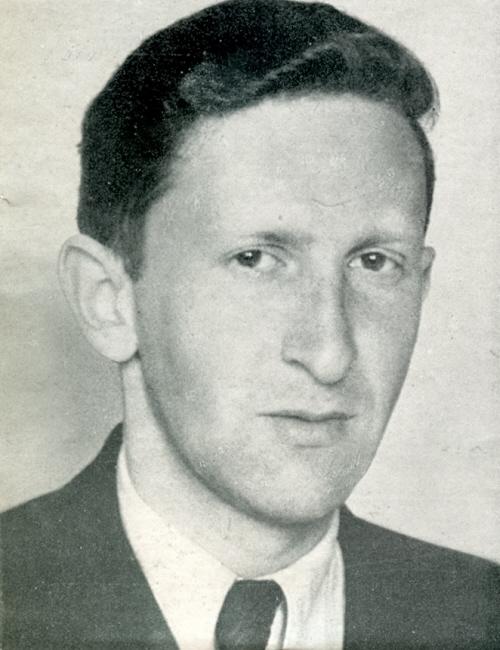
Source: Chess in Russia by P.
Romanovsky, opposite page 26 (London, 1946).
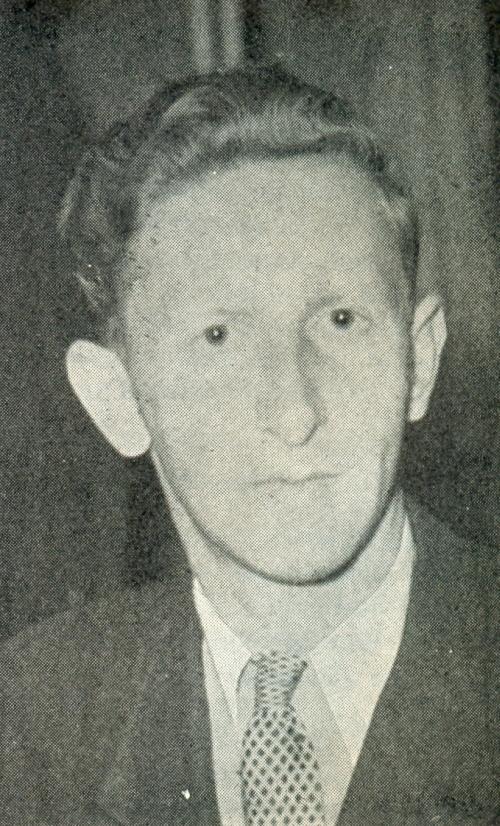
Source: Groningen 1946 by M. Euwe and H. Kmoch (Groningen, 1947).
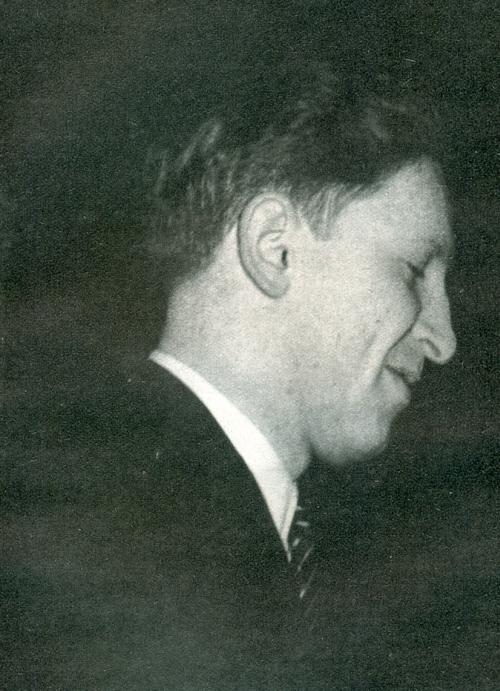
Source: Le Championnat du Monde des échecs 1948 à la portée de tous by C. Seneca, opposite page 204 (Paris, 1948).
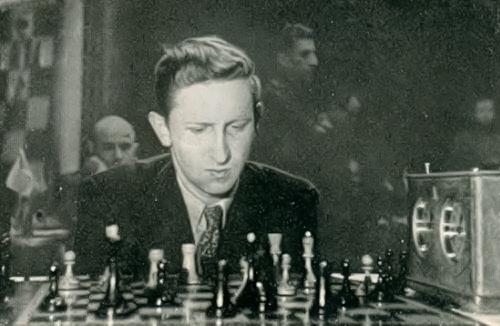
Source: Die Schacholympiade in Helsinki 1952 by H. Müller (Vienna, 1953).
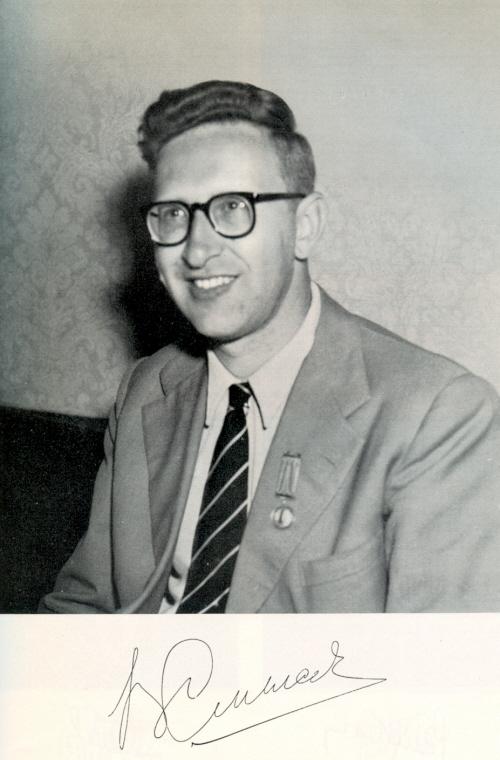
Source: Schach-Elite im Kampf, opposite page 30 (Zurich, 1954).
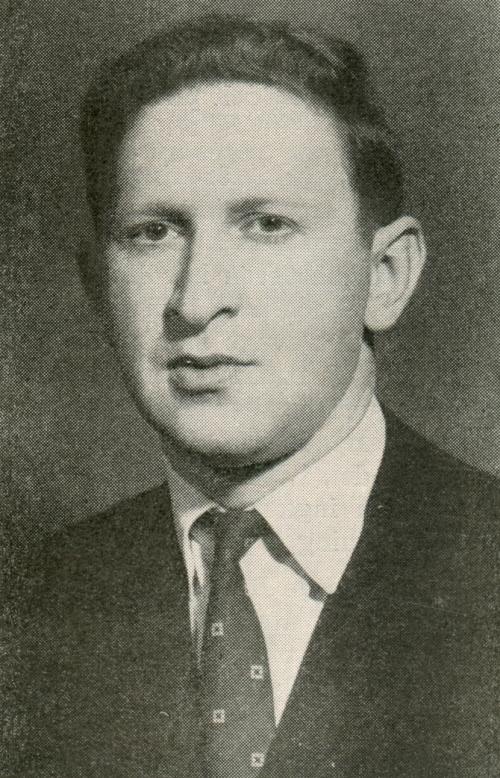
Source: Turneringsbok by G. Ståhlberg and P. Keres, page 11 (Örebro, 1954).
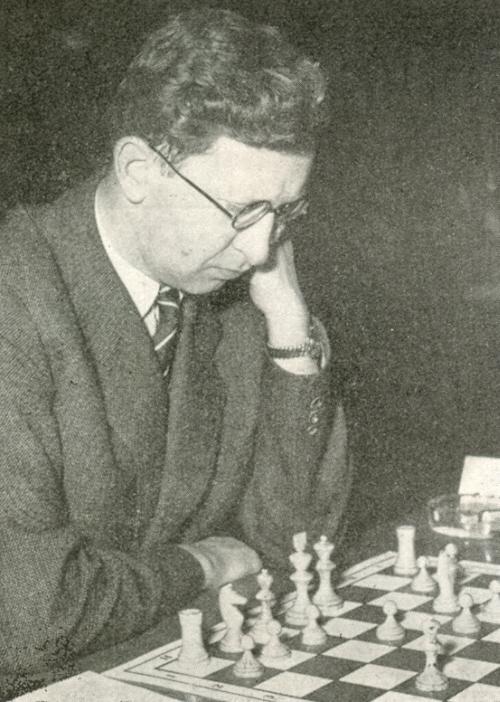
Source: Turneringsbok by G. Ståhlberg and P. Keres, page 138 (Örebro, 1954).
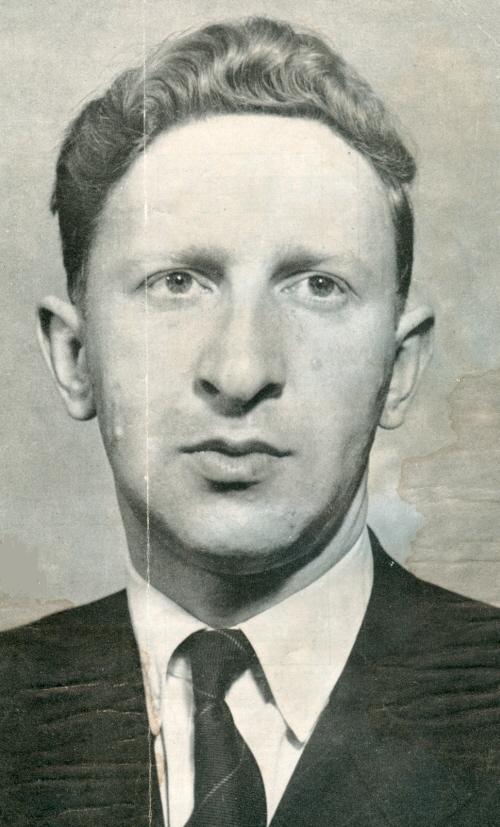
Source: Chess Review, front
cover, April 1958.
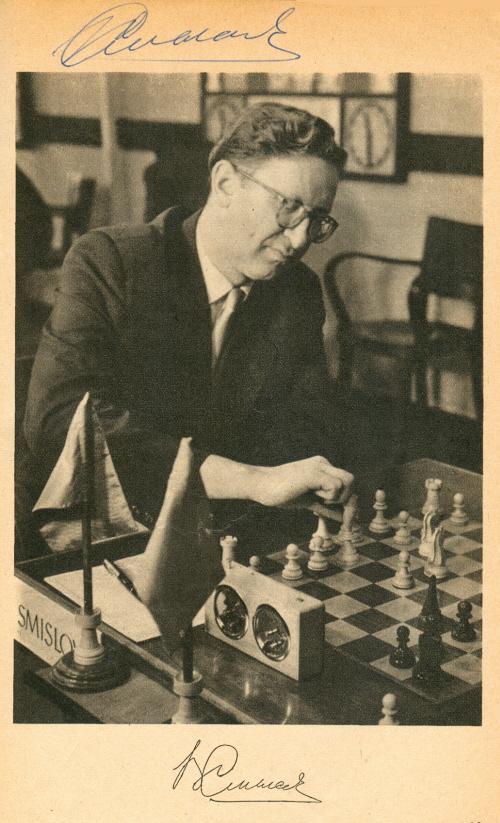
Source: Kandidatenturnier für Schachweltmeisterschaft by S. Gligorić and V. Ragozin, page 39 (Belgrade, 1960).
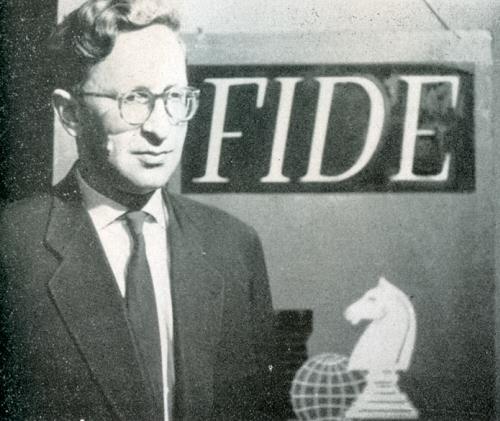
Source: Chess Review, December 1959, page 371.
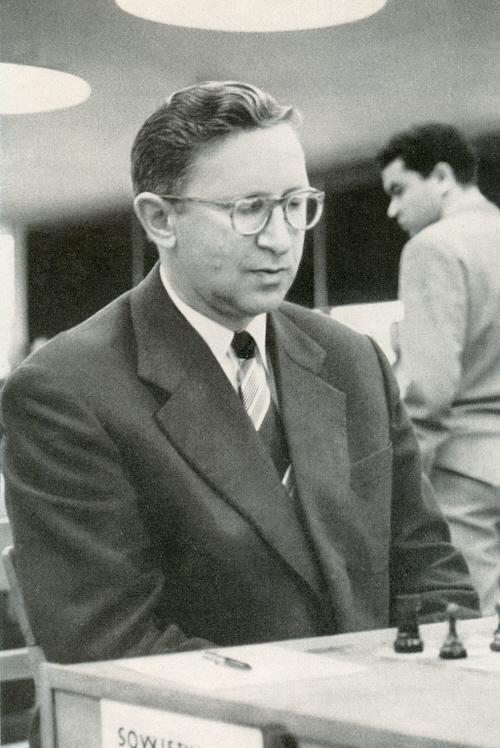
Source: XIV. Schach-Olympiade Leipzig 1960, page 31.
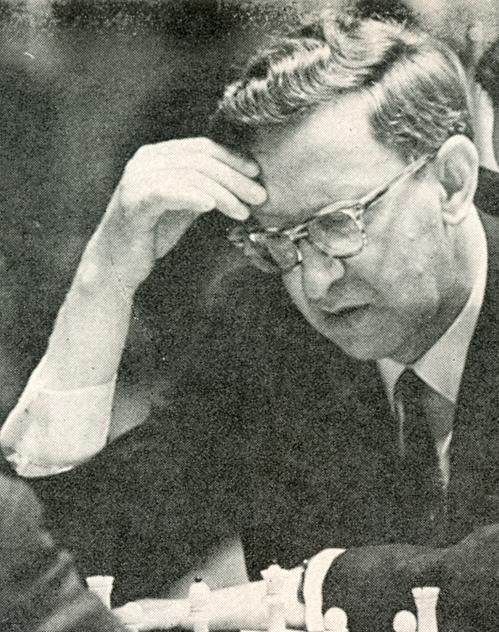
Source: Chess Review, November 1967, page 337.
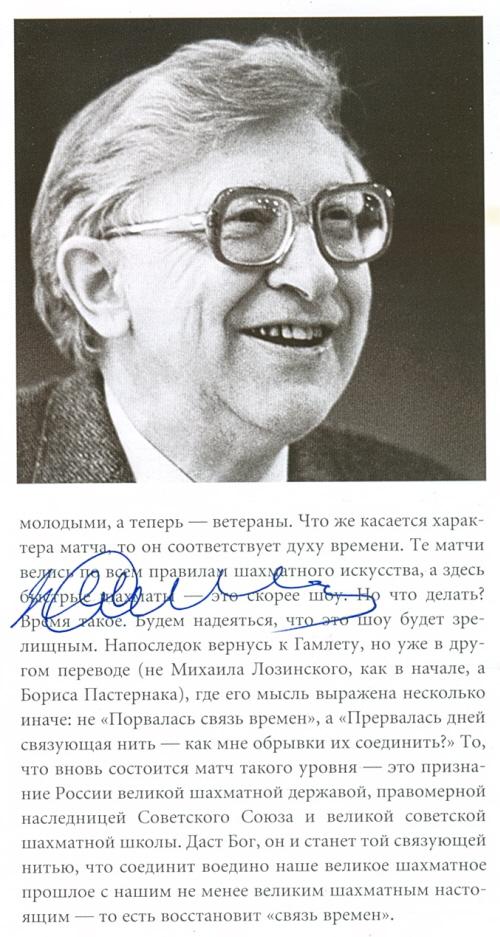
Source: Programme, Russia v Rest of the World tournament, 2002, page 7.
6513. Goniff/Ganef/Gonim/Ganeff
Further to C.N. 6509 (Blackburne v Lipschütz, New York, 1889), Stephen Davies (Kallista, Australia) notes a passage on page 56 of Grandmasters of Chess by Harold C. Schonberg, (Glasgow, 1975):
‘It was during the above New York 1899 [sic] tournament that Blackburne demolished S. Lipschütz. The Jewish player remarked to the spectators, “Der alte Goniff hat mir geschwindeit [sic]!” – “The old crook has swindled me”. Blackburne, who knew German but not Yiddish, went around asking if “Goniff” meant “gentleman”.’
Our correspondent also notes the following on pages 186-187 of The Delights of Chess by Assiac (London, 1960):
‘One of Mieses’ favourite stories was concerned with old Blackburne, who, at some Continental tournament, had asked him the meaning of the word ganef.
“Why do you want to know?”, asked Mieses.
“Well”, said the Englishman, “after I had trounced Gunsberg this morning I heard him say to someone: ‘Der alte Ganef hat mich mattgesetzt.’ I know, of course, that der alte means old and mattgesetzt means mated. But what the dickens is a ganef?”
Mieses was loath to tell him that, strictly speaking, it was Yiddish for “crook”. So he told him not to worry. The word didn’t really mean much, and the way Gunsberg had used it, he certainly had meant no offence.
But the stubborn old Englishman wasn’t satisfied with so vague an explanation, and when Mieses kept on giving evasive answers, Blackburne asked him point-blank: “Tell me one thing. Can one be a ganef and a gentleman at the same time?’
After some consideration, Mieses reassured him on this point.’
Mr Davies asks whether a contemporary source is available for this anecdote.
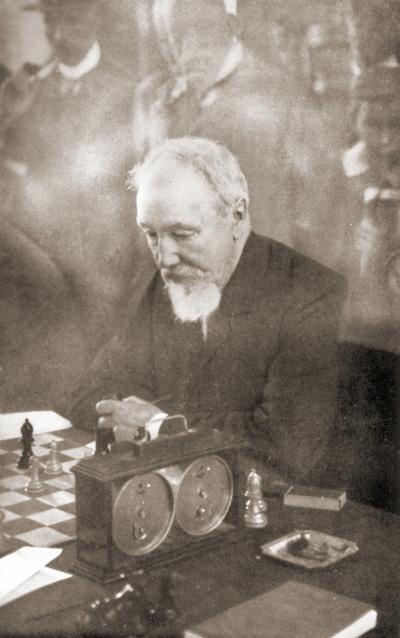
Joseph Henry Blackburne
We note, firstly, that the Schonberg passage was not in the original (1973) publication of Grandmasters of Chess but appeared (with the amendments 1889 and geschwindelt) on page 70 of the revised and updated 1981 edition.
M.V. Anderson of Melbourne asked about the origins of the story (the alleged exclamation being ‘The Gonim has swindled me again’) on page 11 of the January 1958 BCM, in D.J. Morgan’s Quotes and Queries column. It was noted that a version (concerning Blackburne and Nimzowitsch at St Petersburg, 1914) had appeared on page 98 of Caïssas Weltreich by M. Euwe and B. Spaak (Berlin-Frohnau, 1956):
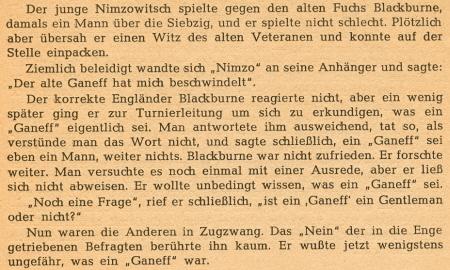
Nimzowitsch made no mention of such an incident when annotating his loss to Blackburne in the Rigasche Rundschau (see pages 133-134 of the June 1918 Deutsche Schachzeitung).
On pages 100-101 of the April 1958 BCM D.J. Morgan reverted to the subject, having been informed by Fred Reinfeld of a passage on pages 344-345 of the Vienna, 1898 tournament book (in the article in Pester Lloyd by Armin Friedmann which was referred to in C.N. 5121). Below is the English translation published on page 62 of the August 1898 American Chess Magazine:
‘Old Mr Blackburne, of London, is also present – a chieftain with the most immovable quietude of soul, whom nothing on earth could throw out of his equanimity. He, too, was at one time a mighty victor, and in many an important contest did he carry off first honors. He bears his misfortunes less tragically; he smokes his short-stemmed pipe, and quietly addresses his victorious antagonist in German, using the only two German words he has learned here – one of which is not German at that – “Grosser Ganef”. The hoary fellow, with his healthy, rosy cheek, and brightly twinkling eyes, has a splendid dry humor ...’
After quoting Reinfeld, D.J. Morgan’s column gave the following:
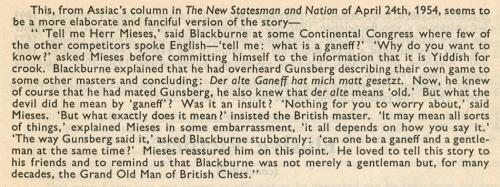
On pages 162-163 of the June 1958 BCM Morgan quoted a contribution to his column from Assiac:
‘As for your Melbourne reader’s query: first, there’s no such word (yiddish or otherwise) as “gonim”, there’s only a ganeff. (In fact, there should be quite a few of them.) Reinfeld’s reference to Vienna, 1898 is very interesting, and the fact that Blackburne had come to like terms such as “Grosser Ganeff” seems to fit in neatly with what Mieses told me about his (prior) experience of reassuring Blackburne that one can be a gentleman and a ganeff at the same time (this sort of ganeff at any rate). Hence, we haven’t two different versions of the same story; we have two different stories, related as cause and effect.’
| First column | << previous | Archives [68] | next >> | Current column |
Copyright: Edward Winter. All rights reserved.